Challenge 6: Behavioral Change for Water Justice
Vibration-based Toilet Leakage Detection System
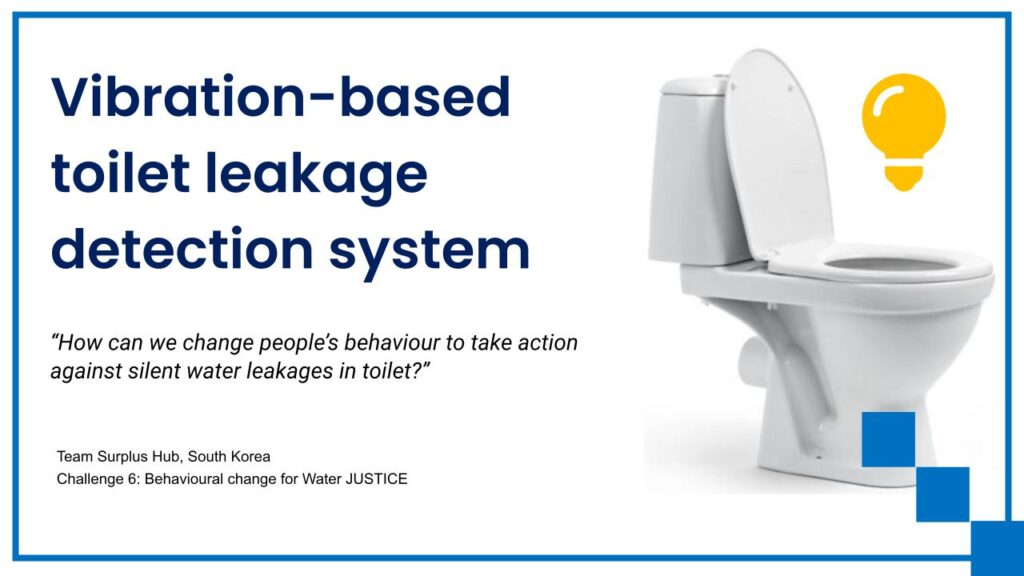
Leakages Are A Big Problem
Every day, every time we drink, wash, flush, rinse, and irrigate, we utilize the life-giving essence of water. But even as we go about these routine tasks, a silent and secret villain wastes our most precious 21st-century resource: water leaks.
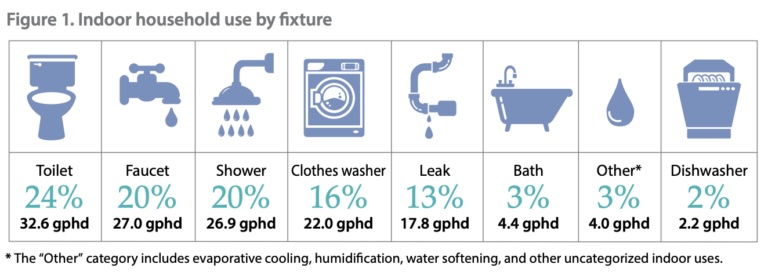
While it might seem surprising, but data from the American Environmental Protection Agency [1] reveals a silent crisis: 13% of all indoor household water use – roughly 25 metric tons per household per year – is wasted due to unnoticed leaks. To put that into perspective, it’s equivalent to filling a small swimming pool or a hefty fuel truck with water and then letting it drain away unnoticed. And what do you think is the largest culprit among these indoor leakages? Toilets. A single unnoticed leak in a toilet can result in a staggering waste of up to 80,000 liters of water in just one month. Which is 25 times more than shower head leakages and 4 times more than faucet leakages. [2]

Now, let’s not forget about toilets outside of our homes. They’re everywhere – in schools, universities, airports, offices, and various other public and private spaces. Maintaining these toilets, especially in public spaces, is a challenging task due to their high usage and the difficulty in regularly monitoring them for leaks. When you consider the sheer number of these toilets and the potential for undetected leaks, the total water wastage is mind-boggling. This paints a picture of a vast, complex problem, but it also highlights the urgent need for an effective solution that can easily be implemented in both private and public settings.
How can behavior change help?

Interestingly, our recent survey conducted in June 2023 has shed light on a crucial aspect of this issue. It revealed that most people, upon noticing a leak, would almost always call a plumber to fix it. So, the primary hurdle isn’t a lack of action, but a lack of awareness. People simply don’t notice these stealthy leaks, and what’s out of sight sadly remains out of mind.
So, how might we alter people’s behavior to enhance water security and reduce water consumption? We believe the solution lies in revealing the hidden.We need to facilitate ways in which unnoticed issues – like hidden leaks – are brought to the attention of property owners. By doing so, we could prompt immediate action, lessening water wastage that might otherwise remain undetected.
Toilets 101 – How exactly do toilet leaks happen?
Leaks in toilets usually occur in two main parts: the flapper valve and the fill valve.
The flapper valve controls the water that passes from the tank to the bowl. When it gets worn out or damaged, water slowly leaks from the tank to the bowl without any noticeable signs, unless you look into the toilet bowl and see the ripples caused by the leaking water.
The fill valve is another common source of leaks. It’s designed to shut off the water supply to the tank once it’s full. A damaged fill valve can cause the water to overflow into the overflow tube, leading to continuous water flow even after flushing.

Now you might be wondering, “If the water is leaking, why is it so hard to spot?” The answer lies in the subtlety of these leaks. Both the flapper valve and fill valve leaks are silent and nearly invisible to the naked eye. Unless you hear a faint hissing sound or see small ripples in the toilet bowl, you might not realize there’s a leak at all.
Furthermore, since toilets are constantly in use, many people might mistake the signs of a leak as just the usual workings of the toilet. This is why leaks can go unnoticed for so long, leading to massive amounts of water waste.
Our Solution: Vibration-Based Real-Time Toilet Leakage Detection System
So, what is our solution? As we have talked before, core idea behind our solution lies in revealing the hidden. That’s why we propose a user-friendly and innovative solution – a vibration-based real-time leak detector designed specifically for toilets. This clever device can sense the subtle vibrations caused by a leak, alerting homeowners to a problem they might otherwise have overlooked.
Why do we use vibration as a signal?
You may wonder how a vibration-based leak detector can help solve this issue. Well, every time water moves or falls, it creates tiny vibrations. These vibrations might be too small for us to feel, but with the right technology, they can be detected and analyzed.
Our leak detector uses an Inertial Measurement Unit (IMU), a sensor combining an accelerometer and gyroscope. This sensor is finely tuned to detect the smallest of motions, making it perfect for detecting the subtle vibrations caused by a water leak in your toilet. Here, in the video demostration, you can see how our prototype can detect the slightest vibrations caused by water flow in a faucet:
Having understood the working principle of our prototype, let’s look into the reasons behind our choice of vibration as a primary detection method. It boils down to four significant advantages: affordability, simplicity, automation, and accuracy
Affordability: Compared to costlier methods like flow meters, vibration detection uses inexpensive sensors, providing a cost-effective yet high-performing solution.
Simplicity: Our device is designed for easy installation, requiring no plumbing expertise or major toilet alterations. This makes it practical for both homeowners and facility managers.
Automation: Unlike manual, time-consuming dye tests, our vibration detector offers continuous, automated monitoring. It does the work for you, detecting leaks and sending alerts, making it ideal for high-usage facilities where manual checks are impractical.
Accuracy: Vibration detection is extremely sensitive, catching even small leaks that visual inspections might miss. This reliable early detection prevents minor leaks from becoming major issues.
Decoding Vibrations: How Can They Help Detect Leaks?
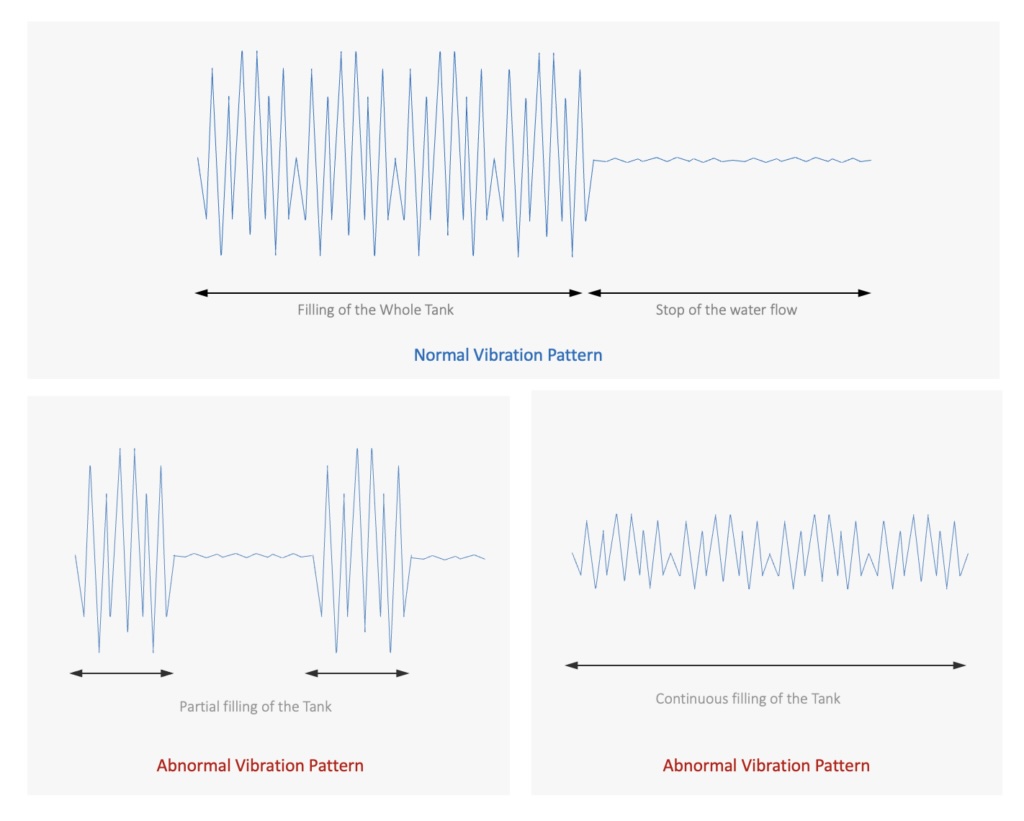
When a toilet operates normally, the water flow and subsequent vibrations occur in predictable patterns. The toilet tank fills up, then water is released when you flush, and then it fills up again. Any deviations from this pattern – like the ongoing vibrations caused by water leaking from the tank into the bowl or continuous flow into the overflow tube – indicate that something is off.
But the real magic happens in the analysis of this data. The device continually tracks the patterns of vibration in your toilet’s water flow. When everything’s working as it should, the amplitude of these vibrations follows a predictable pattern. However, any continuous vibrations that fall outside the expected pattern could be a sign of a leak.
When such irregularities are detected, the device immediately springs into action and sends an alert to a connected application on your smartphone. But this system can be more than just an alerting device. It might also provide essential details about the leak, such as its location, severity, and detection time, helping you make an informed decision on how to respond promptly.
Changing Behaviour: Bringing the Unseen Leaks into Light
Most environmental groups stress the importance of regular checks and repairs for toilet leaks, as they are not only prevalent but also preventable if detected. However, spotting these leaks is often challenging due to the hidden nature of pipes and the inherently damp environment of toilets. This issue is further compounded in public restrooms, where the responsibility for addressing leaks is often unclear, leading to delayed action.

According to our survey, a surprising 83% of people indicated they would call a plumber if they knew a leak was present. Therefore, our focus must be on enabling individuals to “confirm the occurrence of a leak.” By doing so, we induce a change in behavior, turning individuals from passive bystanders into active participants in water conservation efforts.
Changing behavior requires creating awareness and providing individuals with actionable triggers to address this issue. Based on the COM-B model of behavior, which is a comprehensive framework for understanding behavior change, noticing or informing water leakage by employing signal-based triggers and visualizations can inspire a behavior shift in the following ways. [3]
- Capability – make the behavior possible: Reveal unnoticed leakage by signal and visualization so that people can notice there is leakage. Also, raise awareness about simple techniques for identifying leaks by promoting the product.
- Opportunity – trigger: Automated leak detection systems can be installed in toilets that trigger an audible or visual alert when leaks are detected. This enables individuals to respond promptly, preventing water wastage.
- Motivation: Displaying possible amounts of water waste or visual representations of real-time wasted water in prominent locations within buildings can encourage people to report or fix leaks promptly by proposing the impact of leakage.

Customer-Based Understanding: A Story of Sung Min-joon, KAIST facility team member
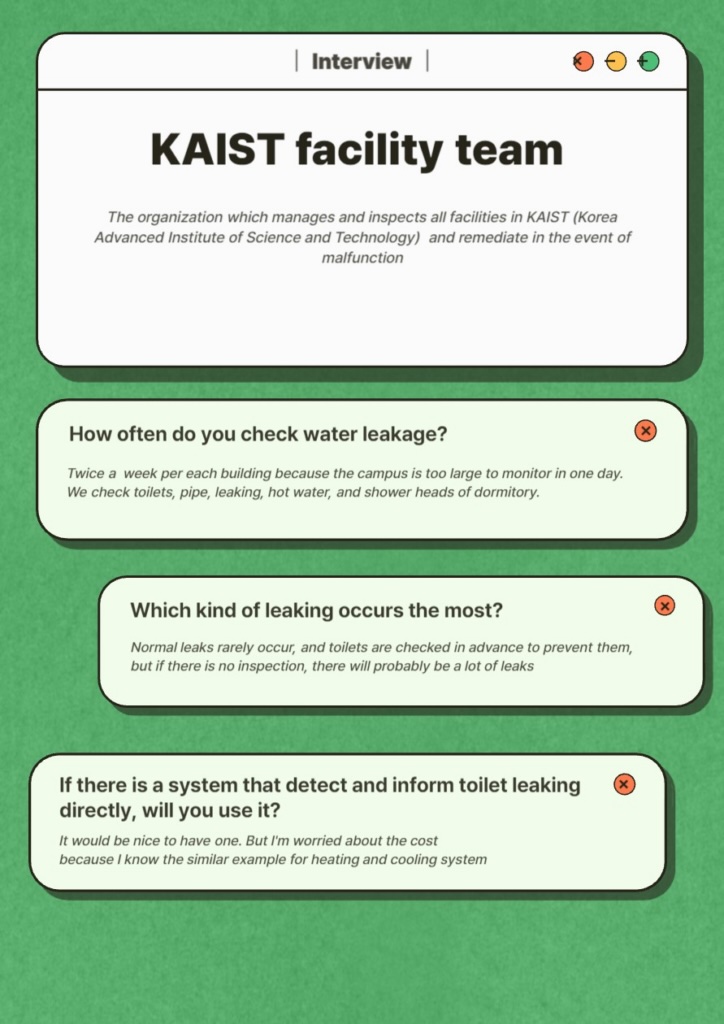
In illustrating the impact and potential of our system, we wanted to showcase a story rooted in the realities faced by those dealing with this issue daily. To do so, we’ve constructed a representative use case, inspired by information we gathered from an interview with a member of a facility management team at KAIST. Let’s explore this scenario, which centers around Sung Min-joon, a fictional character embodying the experiences and challenges shared with us.
Sung Min-joon, a diligent member of the facility management team at KAIST, was determined to find a solution to reduce water wastage in the campus toilets. After purchasing an automated leakage detection system, he successfully implemented it and witnessed a significant reduction in water wastage.
As the Toilet Repair Manager, Sung Min-joon used to manually check the toilets twice a week for leaks. However, with the new automated system in place, he now receives instant notifications whenever a leak is detected.
Thanks to the system’s timely alerts and precise location information, Sung Min-joon can quickly address the leaks, minimizing water wastage and preventing potential damage. The system has not only improved efficiency but also allowed him to focus on other important maintenance tasks.
Sung Min-joon’s proactive approach, combined with the implementation of the automated leakage detection system, has led to a significant decrease in water wastage and a more sustainable environment in the KAIST toilets.
SWOT

Strengths:
- Effective Leakage Detection: The system’s ability to detect vibrations in water flow provides an efficient method for identifying potential leaks in toilet pipes, allowing for timely intervention and prevention of water wastage and damage.
- Non-Intrusive Technology: By utilizing vibration detection, the system does not require invasive installation or modifications to existing plumbing systems, making it a convenient and cost-effective solution for building owners and facility teams.
- Real-Time Alerts: The system’s capability to provide real-time alerts enables immediate response and intervention, minimizing the risk of extensive damage and reducing repair costs.
- Applicability: This system and product can be applied to any type of toilet which has a pipe and not only building’s but also in households. Furthermore, it can be applied to some pipe based water usage facilities.
- Easy Integration: The product can be seamlessly integrated with existing infrastructure and building management systems, enhancing overall functionality and streamlining maintenance processes.
Weaknesses:
- Limited Scope: The system’s effectiveness is confined to detecting leaks specifically in toilet pipes now because it should compare the pattern of flushing and abnormal pattern as signal.
- False Positives: Vibrations in toilet pipes can occur due to factors other than leaks, such as water pressure fluctuations or normal usage patterns that we didn’t expect. The system may have limitations in differentiating between genuine leaks and false alarms, requiring additional manual verification.
Opportunities:
- Market Demand: Water conservation and sustainability initiatives are gaining prominence globally. The demand for reliable leakage detection systems presents an opportunity to capitalize on the growing market and meet the needs of environmentally conscious building owners and facility teams.
- Integration with IoT and Analytics: The product can be enhanced by integrating it with Internet of Things (IoT) technologies and advanced analytics. This integration would enable more comprehensive monitoring, data analysis, and predictive maintenance capabilities.
Threats:
- Competitive Landscape: The market for leakage detection systems is becoming increasingly competitive, with various technologies and solutions available. Competitors offering alternative detection methods or comprehensive plumbing monitoring systems may pose a threat to market penetration and adoption.
- Cost and ROI Considerations: Building owners and facility teams may have budget constraints and may require a compelling return on investment (ROI) to justify the adoption of the system. Demonstrating the cost-saving benefits and long-term value proposition is crucial to overcoming this threat.
By leveraging its strengths and opportunities, while addressing weaknesses and mitigating threats, the water leakage detection product and system for toilets by detecting vibration of water flow in toilet pipes can position itself as an effective and valuable solution in the market, contributing to water conservation efforts and building sustainability.
Business Model
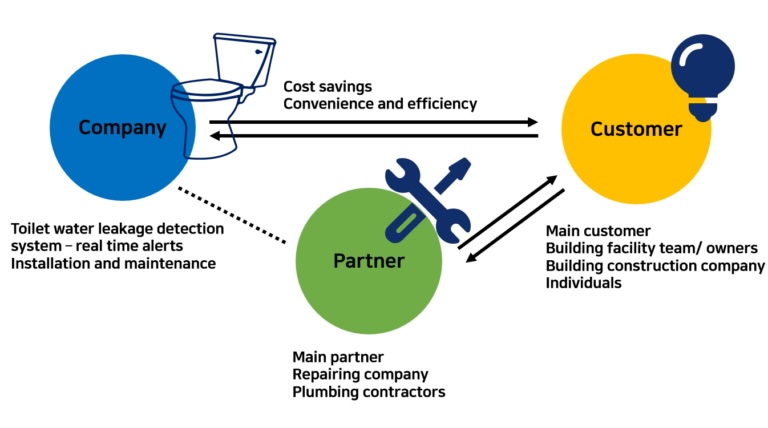
Target customers consist of building facility teams and owners who are responsible for managing and maintaining the facilities, as well as individual households.
The company, our product, and our services enable customers to detect toilet water leakage promptly and conveniently. By utilizing the vibrations induced by water flow in pipes, the system offers an effective and simple method of leak detection, allowing customers to address potential issues early on and prevent water wastage.
We provide a toilet water leakage detection system that includes the actual product itself, and installation services to ensure proper setup and functionality. Furthermore, we offer maintenance services to ensure the continuous and efficient operation of the system. That’s where our revenue comes from.
Repairing companies can be our valuable partners. Collaborating with these companies allows us to establish referral networks or service contracts, where they can recommend or provide repair services to customers who encounter leaks identified by our system.
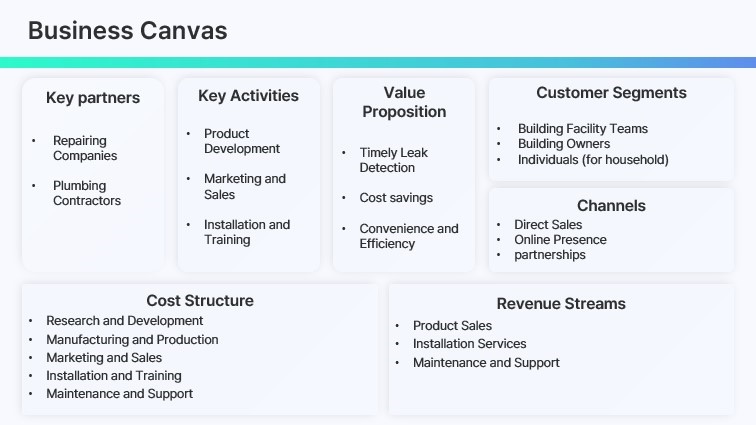
SDGs

SDG Goal 6: Clean Water and Sanitation
By detecting and addressing toilet water leakage, the project contributes to ensuring access to clean and sustainable water resources. It helps in conserving water and preventing wastage, aligning with SDG 6’s objective of sustainable management of water and sanitation for all.
SDG Goal 11: Sustainable Cities and Communities
The project promotes sustainable urban development by addressing water leakage in households. It contributes to creating resilient and inclusive cities where resources are efficiently managed, reducing the strain on water infrastructure and supporting sustainable living conditions.
SDG Goal 12: Responsible Consumption and Production
The toilet water leakage device encourages responsible water consumption by detecting leaks and minimizing water waste. It aligns with SDG 12’s objective of promoting sustainable consumption and production patterns, ensuring the efficient and sustainable use of water resources.
Team introduction

References
[1] – https://www.circleofblue.org/wp-content/uploads/2016/04/WRF_REU2016.pdf
[2] – https://www.epa.gov/system/files/documents/2023-05/ws-commercial-watersense-at-work_Section_2.3_Leak_detection.pdf
[3] -Michie, S., van Stralen, M. M., & West, R. (2011). The behaviour change wheel: A new method for characterising and designing behaviour change interventions. Implementation Science, 6(1), 42.
